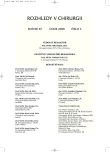Benefits of Intraoperative N. Laryngeus Recurrens Neuromonitoring in Thyroid Surgery
Authors:
B. Dudešek; J. Duben; L. Hnátek; Musil T. Gatěk J. Hradská K.; J. Kotoč
Authors‘ workplace:
Chirurgické oddělení Nemocnice ATLAS a. s. Zlín, přednosta: prim. MUDr. J. Gatěk Ph. D.
Published in:
Rozhl. Chir., 2008, roč. 87, č. 2, s. 80-85.
Category:
Monothematic special - Original
Overview
Introduction:
N. laryngeus reccurens injury is a serious complication in thyroid surgery. Nerve visualization is a procedure preventing its traumatization. The visualization with additional intraopertive neuromonitoring results in further reduction of the n. laryngeus reccurens injury rates.
Aim:
Verification of the intraoperative neuromonitoring effects on reduction of the n. laryngeus reccurens injury rates.
Material, Methodology:
309 operated patients were included in the intraoperative neuromonitoring prospective study . A total of 295 patients were included in the study and intraoperative monitoring was performed per protocol.
Results:
Out of the total of 295 subjects, 1 patient sufferred from permanent paresis, ie. 0.33%, nerves at risk 0.2%. 6 subjects sufferred from transient pareses, i.e. 2.03%, nerves at risk 1.2%, with a prevailing 8-week recovery period of the ORL findings.
Conclusion:
Intraoperative neuromonitoring in thyroid surgery is yet another option for reduction of the n. laryngeus reccurens intraoperative injury rates.
Key words:
n. laryngeus reccurens – visualization – intraoperative neuromonitoring
Sources
1. Dvořák, J., Kubín, S., Schuster, J., Hlavatý, T. Hledání, identifikace a vizualizace nervus laryngeus recurrens při tyreoidektomii - stálé chirurgické dilema. Rozhl. Chir., 2002, roč. 81, č. 6, s. 282–289.
2. Dvořák, J. Štítná žláza, chirurgická anatomie, operační technika. Monografie. Sefira Praha 2000, s. 322.
3. Mocňáková, M., Vyhnánek, J., Duda, M. Neurostimulace – prevence poranění n. laryngeus reccurens při tyreoidektomii. Rozhl. Chir., 2006, roč. 85, č. 9, s. 441–445.
4. Mayer, Th., Hamelmann, W., Hoppe, F., Timmermann,W. Intraoperatives Neuromonitoring des Nervus laryngeus recurrens, Chir. Praxis, 2002, 60, s. 615–622.
5. Vykus, V., Svoboda, J., Pospíšilová, G., Tauš, M. Chirurgie štítné žlázy – příspěvek k diskusi o technice operování. Rozhl. Chir. 2004, roč. 83, s.403–405.
6. Zimmermann, W., Hamelmann,W., Thiede, A. Schilddrüsenchirurgie: Neuromonitoring zur Schonung des Nervus recurrens. Deut. Ärzteblatt, 2004, 101, 19, s. 1341–l345.
7. Fliesberg, K., Lindholm, T. Electrical stimulation of the humen recurrent laryngeal nerve during thyroid operation. Acta Otolaryngol., 1969, 263, s. 63–67.
8. Tomusch, O., Sekula, C., Walls, G., Machens, A., Dralle, H. Intraoperative neuromonitoring of surgery for benign goiter. Am. J. Surg. 2002, l8, s. 673–678.
9. Chan, W. F., Lo, C. Y. Pitfalls of intraoperative neuromonitoring for predicting postoperative recurrent laryngeal nerve function during thyreoidectomy. Word J. Surg., 2006, 30 (5),s. 806–812.
10. Timmermann, W., Hamelmann, W., Thomusch, O., Sekula, C., Grond, S., Neumann, H., Kruse, E., Mühlig, H., Richter, C., Voss, J., Dralle, H. Zuverlässigkeit und Konsequenzen des intraoperativen Neuromonitorings in der Schilddrüsenchirurgie. Chirurg, 2004, 75, s. 916–922.
11. Steurer, M., Passler, C., Denk, D., Schneider, B., Mancusi, G., Schickinger, B., Niederle, B., Bigenzahn, W. Funcional laryngeal result after thyreoidectomy and extensive recurrent laryngeal nerve dissection without neuromonitoring. European Surgery, 2005, 35, s. 262–267.
12. Hermann, M. Hellebart, C., Freissmuth, M. Neuromonitoring in thyreoid surgery: Prospective evaluation of intraoperative elekrophysiological responses for the prediction of recurrent laryngeal nerve injury. Ann. Surg.. 2004, 240, s. 26–27.
13. Límanová, Z., Němec, J., Zamrazil, V. Nemoci štítné žlázy. Praha: Galen 1995, s. 81.
14. Dralle, H., Zimmermann, W., Kruse, E., Grond, S., Hamelmann, W., Neumann H., Richter, Ch., Mühling, H., Blenkenburg, Ch., Kampf, E., Lorenz, K., Sekula, C. Was bringt das Neuromonitoring für die Schilddrüsenchirurgie? Arzt und Krankenhaus 2004, 12, s. 369 – 376.
Labels
Surgery Orthopaedics Trauma surgeryArticle was published in
Perspectives in Surgery

2008 Issue 2
Most read in this issue
- „Tension Free“ Method in Inguinal Hernioplasty Using CHS 100 Mesh – Our Experience
- Benefits of Intraoperative N. Laryngeus Recurrens Neuromonitoring in Thyroid Surgery
- Spontaneous Rupture of Ductus Choledochus in Acute Pancreatitis – a Case Report
- Surgical Management of Proximal Humeral Fractures Using the Hackethal (Zifko) Method – A Case Review
